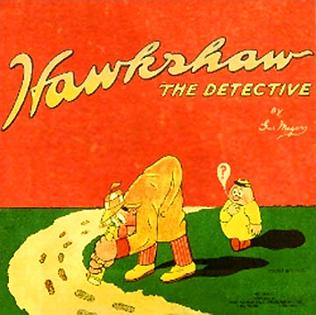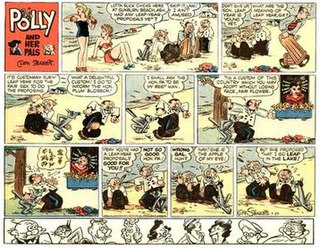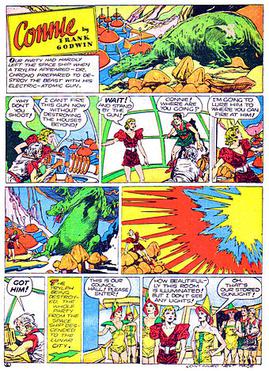
Joe Palooka was an American comic strip about a heavyweight boxing champion, created by cartoonist Ham Fisher. The strip debuted on April 19, 1930 and was carried at its peak by 900 newspapers. It was cancelled in 1984.

Mutt and Jeff was a long-running and widely popular American newspaper comic strip created by cartoonist Bud Fisher in 1907 about "two mismatched tinhorns". It is commonly regarded as the first daily comic strip. The concept of a newspaper strip featuring recurring characters in multiple panels on a six-day-a-week schedule had previously been pioneered through the short-lived A. Piker Clerk by Clare Briggs, but it was Mutt and Jeff as the first successful daily comic strip that staked out the direction of the future trend.
Paul Murry was an American cartoonist and comics artist. He is best known for his Disney comics, which appeared in Dell Comics and Gold Key Comics from 1946 to 1984, particularly the Mickey Mouse and Goofy three-part adventure stories in Walt Disney's Comics and Stories.

Wash Tubbs is an American daily comic strip created by Roy Crane that ran from April 14, 1924 to 1949, when it merged into Crane's related Sunday page, Captain Easy. Crane left both strips in 1943 to begin Buz Sawyer, but a series of assistants, beginning with Leslie Turner, kept the combined Captain Easy daily and Sunday strips going until October 1, 1988.

Jane Arden was an internationally syndicated daily newspaper comic strip which ran from November 26, 1928 to January 20, 1968. The title character was the original "spunky girl reporter", actively seeking to infiltrate and expose criminal activity rather than just report on its consequences and served as a prototype for later characters such as Superman supporting character Lois Lane and fellow comic strip heroine Brenda Starr, Reporter. Pulitzer Prize-winning columnist Mary McGrory credited Jane Arden with instilling her interest in journalism.

Hawkshaw the Detective was a comic strip character featured in an eponymous cartoon serial by Gus Mager from February 23, 1913, to November 12, 1922, and again from December 13, 1931, to 1952. The name of Mager's character was derived from the common American slang of the time, in which a hawkshaw meant a detective—that slang itself derived from playwright Tom Taylor's use of the name for the detective in his 1863 stage play The Ticket of Leave Man.
Notable events of 1936 in comics. See also List of years in comics.

Morris S. Weiss was an American comic book and comic strip artist and writer. Active from the 1930s through the mid-1970s, he created the teen-comedy character "Margie" for Timely Comics, the 1940s predecessor of Marvel Comics, and was the final cartoonist on the comic strip Mickey Finn. He also worked as a writer or illustrator on numerous other strips, including Joe Palooka.
Anthony Louis DiPreta was an American comic book and comic strip artist active from the 1940s Golden Age of comic books. He was the longtime successor artist of the comic strip Joe Palooka (1959–84) and drew the Rex Morgan, M.D. daily strip from 1983 until DiPreta's retirement in 2000.
King of the Royal Mounted is an American comics series which debuted February 17, 1935 by Stephen Slesinger, based on popular Western writer Zane Grey's byline and marketed as Zane Grey's King of the Royal Mounted. The series' protagonist is Dave King, a Canadian Mountie who always gets his man and who, over the course of the series, is promoted from Corporal to Sergeant. King has appeared in newspaper strips, comics, Big Little Books, and other ancillary items.

Our Boarding House is an American single-panel cartoon and comic strip created by Gene Ahern on October 3, 1921 and syndicated by Newspaper Enterprise Association. Set in a boarding house run by the sensible Mrs. Hoople, it drew humor from the interactions of her grandiose, tall-tale-telling husband, the self-styled Major Hoople, with the rooming-house denizens and his various friends and cronies.

Polly and Her Pals is an American comic strip, created by cartoonist Cliff Sterrett, which ran from December 4, 1912, until December 7, 1958. It is regarded as one of the most graphically innovative strips of the 20th century. It debuted as Positive Polly on December 4, 1912, in William Randolph Hearst's newspapers, initially the New York Journal, and was later distributed by King Features Syndicate. The title changed to Polly and Her Pals on January 17, 1913.

Connie is an American adventure comic strip created by the cartoonist Frank Godwin, who introduced a book illustration style to the comics page. The strip ran from 1927 to 1941 for the Ledger Syndicate. Connie debuted as a Sunday page on November 13, 1927. The strip was syndicated in France as Cora in the weekly paper Le Journal de Mickey.

The McNaught Syndicate was an American newspaper syndicate founded in 1922. It was established by Virgil Venice McNitt and Charles V. McAdam. Its best known contents were the columns by Will Rogers and O. O. McIntyre, the Dear Abby letters section and comic strips, including Joe Palooka and Heathcliff. It folded in September 1989.

Frank E. Leonard, better known as Lank Leonard, was an American cartoonist artist who created the long-running comic strip Mickey Finn, which he drew for more than three decades.

Alvah Posen was an American cartoonist on several comic strips, but he is best known for his 1933-1960 comic strip Sweeney & Son and as co-producer of the now-lost Marx Brothers film, Humor Risk (1921).

Annibelle was a comic strip created in 1929 by Dorothy Urfer. It was first published as a single panel cartoon on December 29, 1929, on the women's page of Newspaper Enterprise Association, Inc.'s Everyweek section. The humorous strip revolves around Annibelle's social life. In 1935, Annibelle began being printed in color. Virginia Krausmann took over the strip in March 1936. Annibelle comics were reprinted in The Funnies. Annibelle last ran on October 15, 1939.
The Public Ledger Syndicate was a syndication company operated by the Philadelphia Public Ledger that was in business from 1915 to circa 1950. The Ledger Syndicate distributed comic strips, panels, and columns to the United States and the United Kingdom, Ireland, Canada, Sweden, New Zealand, and Australia. The syndicate also distributed material from the Curtis Publishing Company's other publications, including The Saturday Evening Post, Ladies' Home Journal, and The Country Gentleman.
Silly Symphony, initially titled Silly Symphonies, is a weekly Disney comic strip that debuted on January 10, 1932, as a topper for the Mickey Mouse strip's Sunday page. The strip featured adaptations of Walt Disney's popular short film series, Silly Symphony, which released 75 cartoons from 1929 to 1939, as well as other cartoons and animated films. The comic strip outlived its parent series by six years, ending on October 7, 1945.
Uncle Remus and His Tales of Br'er Rabbit is an American Disney comic strip that ran on Sundays from October 14, 1945, to December 31, 1972. It first appeared as a topper strip for the Mickey Mouse Sunday page, but after the first few years, almost always appeared on its own. The strip replaced the 1932-1945 Silly Symphony strip, which had spent its final year on gag strips featuring Panchito from The Three Caballeros.














